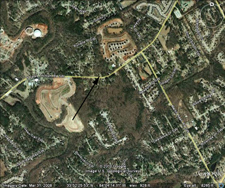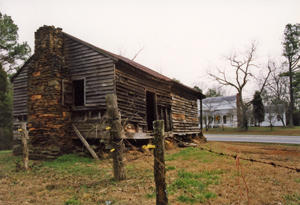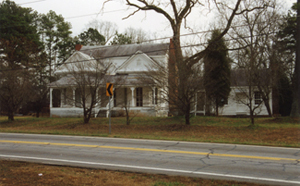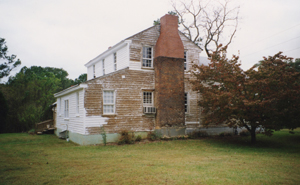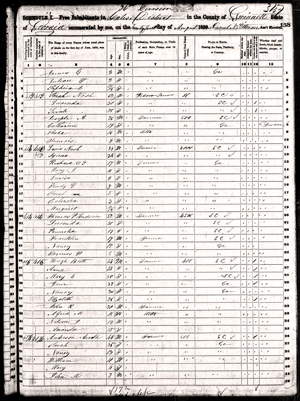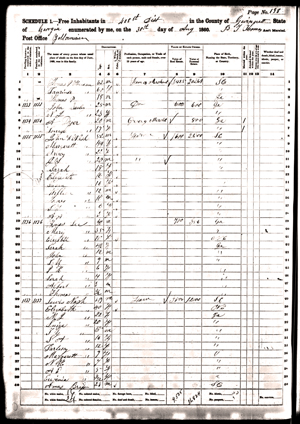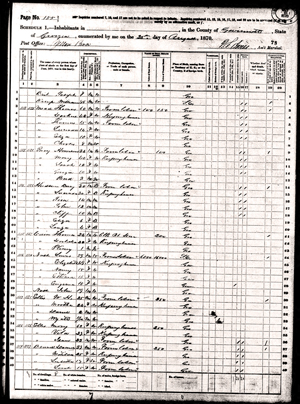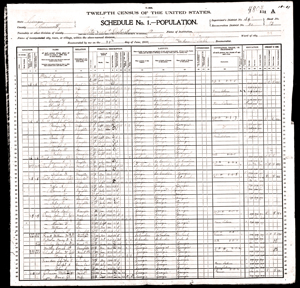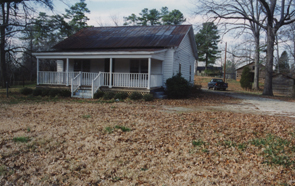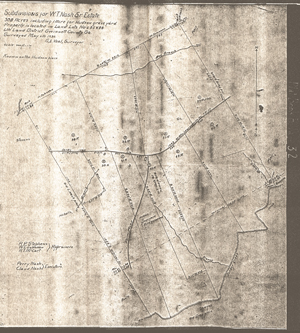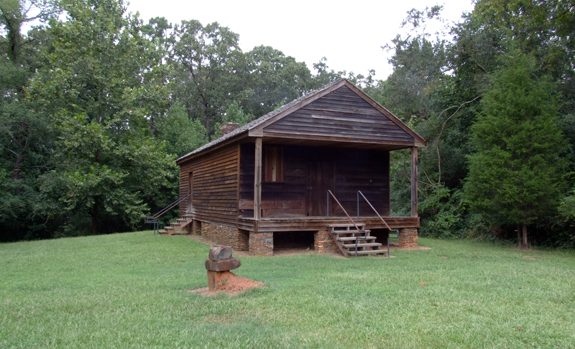The building that housed Hudson's Store and the Yellow River Post Office in the years before the Civil War was part of a complex of structures now known as the Hudson-Nash Farm, a National Register of Historic Places property located on Five Forks-Trickum Road a few miles southwest of Lawrenceville, Georgia. The National Register nomination describes the site's significance as
a mid-19th century farm and commercial property. The farmstead with several outbuildings and the general store/post office served as a center for the small dispersed community of Yellow River. This type of complex was found throughout rural Georgia and provides as excellent example of the type of development found in Gwinnett County.
Of the 85-acre National Register district, Gwinnett County owns a tract of 5.116 acres which with a similar family-owned area around the Hudson-Nash House across Five Forks-Trickum Road formed the core of the historic farm. In 1998, seven of the ten buildings that were noted by the National Register as contributing to the significance of the site were on the present county-owned property. The most-significant of the county-owned structures are Hudson’s store/post office and a surviving slave/tenant house that are both significant historic structures in their own right. Both built in the 1840s (and expanded in the 1850s), these structures are quite rare in the metropolitan Atlanta area. Few of these antebellum farm and commercial structures have survived the tremendous changes that have occurred in the twentieth century, particularly the suburban growth that transformed Gwinnett County in the last half of the twentieth century.
|
Figure 1. The post office and general store on their original site across the road from the Hudson-Nash House in 1998. |
Hudson Farm
The loss of the county’s earliest records in a courthouse fire in 1871 has made documentation of the site’s early history difficult, but its traditional association with Thomas Parks Hudson (1798–1862) is generally accepted. He was born in Greenville County, South Carolina, the son of Lunsford Hudson (1768–1856) and Amelia Parks Hudson (1781–1863). He married Lurinda Green (1800–1877), the daughter of George Green (1767–1852) and Diana James Green (1776–1866), in 1819, and the first of nine children was born in South Carolina in 1821. There were six more before the family moved to Jackson County, Georgia, around 1834. According to family tradition, the famly moved to Gwinnett County in 1838; the last two children were born there. [1]
|
Figure 2. View southeast of Hudson-Nash House, with the detached kitchen visible at right. The gables were added to the front of the house in 1911. |
|
Figure 3. View west of Hudson-Nash House in 1998. It was built in the plantation-plain style around 1840 and remodeled in the 1880s. |
By the time the Federal census was taken in the summer of 1840, he appears to have almost certainly established the family on Land Lot 88, 6th District, just east of Yellow River. It is probable that he had already built his house by that time and, since the enumeration of the 408th G.M.D. for the census began with his household, it is possible that Hudson’s Store was already something of a community center.
In September 1845, the Georgia Railroad was completed from Augusta to the terminus of the Western and Atlantic Railroad at Marthasville (now Atlanta). Gwinnett County was eager for access to the new railroad and, in November 1845, ordered Thomas Hudson, Robert Craig and John Bankston to “mark out the road leading from Lawrenceville to the road cut out by DeKalb from the depot near Stone Mountain to the Gwinnett County line” and to do the same for a road “from the depot [at Stone Mountain] to Hudson’s storehouse,” indicating that there was probably already a road between the store and Lawrenceville.[2] The character of the existing building is such that we may assume that the “storehouse” mentioned in the court minutes in 1845 is almost certainly the same building now known as the “Yellow River Post Office.” With the opening of the new road to Stone Mountain, which presumably occurred in early 1846, Hudson had relatively easy access to both Lawrenceville and to the railroad and his store was the logical place for establishing a post office for the Yellow River community in 1846. Thomas Hudson was the first post master at Yellow River, serving in that post until his death in 1862.
Hudson also served as county surveyor from 1850 to 1855 and was active in state politics as well. He served several terms in the Georgia General Assembly, 1853–1856 and 1861–1862. He was, according to a biography published in 1871, “a fine business man with fine sense, fine judgment, a fine scribe, good accountant, and a man far above the average in intelligence.” [3]
|
Figure 5. Federal census schedule from 1860, showing Thomas P. Hudson and family. |
|
Figure 6. Federal census schedule from 1870, showing Thomas Cain and family |
Merchants prospered in the 1850s and Hudson appears to have been no exception, especially after the road was extended to Stone Mountain. It was probably as a result of increased business that the addition was made to the original storehouse/post office building that brought the building to its current configuration. There are only slight differences in the structure, materials and finishes between the original building and the addition and the overall character of the addition indicates that it was also built before the Civil War.
By 1860, Hudson owned thirteen slaves, a marked increase from the two that he and his son had recorded in 1840 and 1850. To house these additional slaves, which were likely to have been in two families, Hudson constructed two houses on his in the 1850s. One of these houses, which originally consisted of a single room and perhaps a loft, still stands, heavily restored, on the north side of the present site. [4]
As a community leader, Thomas Hudson was chosen as one of Gwinnett County’s three delegates to the convention in Milledgeville that adopted the Ordinance of Secession in 1861. Like most merchants, he feared the economic upset that war would bring and voted against the measure, but then went on to raise a troop of home guards (“Hudson Guards,” Company H, 10th Regiment, Georgia State Troops) that held rifle practice in the ravine northeast of the store. [5]
Hudson’s store was a focal point of activity during the war, both as a place for receiving mail and the latest news but also as the source of much-needed staples and supplies in the increasingly hard years of the war. Hudson wrote a letter to Gov. Joseph E. Brown in December 1861, requesting “25 or 30 sacks” of salt “for my neighbors,” who were then in the middle of their annual early-winter hog butchering. Salted meat was one of the main staples of the Southern diet and Hudson’s neighbors were desperate when they discovered that the war was depriving them of one of the few things that they absolutely had to have but that they could not produce themselves. Noting the profiteering that was already beginning to occur, Hudson assured the governor that the salt was “not for speculation” and that his neighbors would get the salt “at cost & carriage.”[6] Whether or not the governor was able to satisfy Hudson’s request is not known, but the letter illustrates the major role that Hudson’s store, and other country stores like it all across the South, played in the life of the local community.
In November of 1862, Thomas Hudson died and was buried in the family cemetery a few hundred yards southwest of his home. [7] His family persevered amid worsening shortages of supplies and other disruptions that would have made operation of the store and post office increasingly difficult. It is not known if the Hudsons, like their neighbor Lewis Nash, “refugeed” from Yellow River as the Federal army poured through Georgia in 1864. Betrayed by a slave, Nash was unsuccessful in hiding his stored food and other items from Federal troops who were scouring the countryside around Atlanta, including the Yellow River community, for supplies in the late summer and fall of 1864. The Hudsons probably suffered the same kind of losses, even if they had decided to stay put and ride out the storm that was sweeping Georgia.
The war must have delayed settlement of Hudson’s estate, which was not closed until 1866. Because of the loss of courthouse records, the details of the estate settlement are not complete, but his youngest son, Thomas P. Hudson Jr., appears to have inherited about 350 of his father’s original 562-acre farm, including all of Land Lots 88 and 89 north and west of Turkey Creek. As was usual, the transfer included the provision that the elder Hudson’s widow’s “right to dower” was “reserved during her life time.”[8]
The ordering of the 1870 census for Yellow River suggests that, by that time, Thomas Hudson Jr. (1842–1917) and his widowed mother were not living in the house and that it may have been rented to David Thomas Cain (1845-1904). Cain’s wife, Darleska (1848–1901), was the daughter of Hudson’s next-door-neighbor Lewis Nash (1811–1895), who was postmaster at Yellow River in 1866 and 1867. Cain listed his occupation as “store rt. clerk” in the 1870 census, and in 1875 he was appointed post master at Yellow River.[9] He served until 1877 when the position was filled by his brother George Washington Cain, who served for two years before turning the position back over to his brother in 1880.
Although the Yellow River Post Office remained in operation until 1903, after the Civil War, it was not located in the original building across from the Hudson-Nash house. The Federal records for post office locations in Gwinnett County date back only to the 1890s, when the U. S. Post Office began mapping post office locations. Although there is no map showing a precise location for the post office, the form completed by Post Master John W. Field Jr. in 1892 states that the Yellow River Post Office was located a little less than a quarter mile east of the Yellow River, a mile west of Turkey Creek, and in “section 89." [10]
Since Hudson’s old store/post office building is located nearly three-quarters of a mile east of the river, less than a half mile west of the creek, and in Land Lot 88, we can assume that the post office had been relocated to the vicinity of the Yellow River Baptist Church in Land Lot 89 by that time. In addition, the fact that Land Lot 89 was the location of the original homestead of John Walker Nash (1782–1849), and later of his son Lewis, is a good indication that the relocation of the post office occurred when Lewis Nash was appointed post master shortly after the Civil War.
In 1873, Thomas E. Daniel announced the opening of the “Yellow River Academy,” scheduled for January 1874. Daniel intended to use “Hudson’s store house” as a class room and to provide room and board for his students if they wished in his home. It is not known if Daniel was successful in this venture nor how long it might have operated.[11]
Hudson-Nash Farm
In 1876, Thomas Hudson Jr. sold the last 350 acres of his father’s 560-acre plantation to their old neighbor Lewis Nash (1811-1895). The son of pioneer John Walker Nash (1782-1849), who had settled along the Yellow River in the 1820s, Lewis Nash had probably inherited Land Lot 89 to the southwest of the Hudsons after the elder Nash’s death in 1849 and bought the old Hudson place in Land Lot 88 simply as an investment for his family.[12]
In the late 1870s, or perhaps the early 1880s, the post office was turned to residential use and rented to William Albert Lee (1858–1923), a son of Hudson’s old neighbor to the west Thomas Lee (1813-–1889). Although both William and his wife died quite young, their granddaughter Willie (1900–1995) married William T. Nash’s youngest son Jewel (1890–1960), who built the house just east of the post office about 1911. It was probably during the 1870s that Hudson’s old store house was partitioned into the two-room structure that exists today, although no other improvements appear to have been made. John Tyler Ewing (1968–1960) also married a member of the Nash clan in 1890, and they, too, are thought to have made their first home in the old Yellow River Post Office. [13] The two old slave houses were probably also rented although the identity of their occupants in the late nineteenth and early twentieth centuries is not known.
Lewis Nash did not own the old Hudson plantation for very long, and about 1880 sold it to one of his Nash cousins, William Thomas Nash (1845-1927). About 1850, Lewis’ uncle Thomas Nash (1794-c. 1851) had decided to join his relatives in Gwinnett County. Having brought the family from South Carolina, however, Thomas died suddenly before the move was complete. His widow and their eight children remained in Georgia anyway, living among their Nash relatives at Yellow River. One of those children was William Thomas Nash and it was with his purchase of the old Hudson place that the Nash era for the site began.
With a new 300-acre farm, William Thomas Nash married Dora Johnson (1860–1941) in December 1880 and the following October the first of their eight children was born. Although Nash was a farmer, conditions had changed radically since the Civil War, which may have been one reason that the Hudsons had relinquished their father’s old farm. With no slaves, Nash, like most of his contemporaries, turned to sharecroppers and tenant farmers to work his land, probably with mixed results. Most of the buildings that Hudson built before the Civil War probably still stood and in use but there is no indication that Nash ever kept a store. In any case, as noted above, the actual operations of the Yellow River Post Office were relocated to another site after the Civil War.
|
Figure 8. The house that William T. Nash built for his son Claude in 1913. The County removed the house from the site after 1998. |
|
Figure 9. Plat made in May 1930 for the subdivision of William T. Nash's 308-acre farm. |
In addition, William T. Nash may have built other houses on the property for his family members or for tenants in the late nineteenth century. One of these sat on the south side of the old road bed across from where Claude Nash’s house would be built in 1913. Another house, which stood just east of the present Edward Nash house, may have been built as a tenant house by Nash or one of his children.
By the time William Thomas Nash’s children were coming of age in the early 1900s, the rural agricultural economy was reaching a sort of heyday that would last until the end of World War I. In 1911, Nash remodeled the old Hudson House by adding rooms to the front of the original two-story house, bringing it to its present appearance. About the same time, he built houses for three of his children and their new families, including a three-room house for his son Claude in 1913.
With the agricultural economy devastated by the arrival of the boll weevil in 1919 and the growing exodus of farm workers for better-paying factory jobs in the cities, much of the rural south began a slow slide toward ruin. By then, the old post office was probably no longer useful as rental property and it is unlikely that it was used for anything but storage after World War I.
With the elder Nash’s death in 1927, the 350-acre tract that he had bought in 1880 was formally divided between his eight children; in 1930, Claud Nash inherited a 32-acre tract that included the old post office and the house that he had built in 1913. About 1936, he remodeled the house by adding two front rooms and a front porch, which brought the house to its present configuration. He also began building new buildings, including a shop, now destroyed, and the existing wash house and wood shed.
In 1939, the Five Forks-Trickum Road was improved and realigned, which necessitated the destruction of the other of Hudson’s old slave houses, then occupied by a family named Haney. [14] Claude Nash salvaged material from the house and incorporated it into the barn that he built to the north of his house about that same time. In the late 1940s, Nash acquired his first tractor and built a small building to the west of the remaining slave house in which to house it. He continued to farm the land through the 1950s.
Claude Nash died in 1969 and, three years later, his heirs sold twenty-seven acres north and west of the post office property for the residential subdivision called Old Dominion. Developed by cousins of the Nashes, the subdivision’s streets were named for four of Claude and Mamie Nash’s children: Hazel Court, Summie Drive, Runelle Place, and Guy’s Court. Descendants of John Walker Nash and his brother Thomas still reside in Gwinnett County today, several of them in the Yellow River area. In 1996, his grandson Claud Ray Cruce Jr. sold 5.116 acres of the historic Hudson-Nash farm to Gwinnett County. [15]
Yellow River Post Office County Park
The County commissioned the present study of the post office in 1998. At that time, planning for widening and realignment of Five Forks-Trickum Road was underway, and the post office was in the right-of-way thought necessary for that work. As a result, in 1999, the County made the decision to relocate the building a short distance north of its original location. To facilitate the move, the stone foundation and chimney and much of the wood-framed structure were dismantled and reconstructed, which significantly diminished the building's integrity. It and the remaining slave/tenant house, which remained on its original location, were heavily restored after that. Around the same time, the Claude Nash House (1913), which sat a few hundred yards west of the post office, and all of its mid-twentieth-century outbuildngs, except for the barn (1939), were demolished.
In January 2019, the Hudson-Nash House itself was moved from its original site on the south side of the road to a new location on the north side, west of the post office. The additions at the front of the house, which were defining features throughout the twentieth century, were removed when the house was relocated, since it is to be restored to its 1840 appearance. Most of the site's integrity as a historic site has now been lost.
|
Figure 10. View north of Yellow River Post Office, August 2010. The structure was moved by the County in 1999 and, in addition to replacement of most of the exterior woodwork, several aspects of the historic building were altered, including large square piers in place of the original stacked stone piers and a significantly different detailing of the gables. The stones and red clay in the foreground mark the northwest (rear) corner of the original building. |
![]()
Endnotes
1. Larry W. Parr, Gwinnett County Records as Recorded in Athens, Georgia, Newspapers, 1827-1949 (Callaway Publishing, 1986), p. 60.
2. J. C. Flanigan, History of Gwinnett County, Georgia, 1818-1943, Vol. 1 (Gwinnett Historical Society reprint, 1995), p. 80.
3. Flanigan, p. 372.
4. 1860 Agricultural Census documents the presence of two slave houses and thirteen slaves. The character of the present building confirms its antebellum origins.
5. Flanigan, p. 228.
6. Copy at Gwinnett Historical Society; location of original not known but probably Gov. Brown’s papers at Georgia Department of Archives and History.
7. The cemetery is recorded in the deeds as encompassing one acre of land. Although the cemetery today is in ruins, evidence of a number of burials are scattered all across the hillside in the vicinity of Thomas Hudson’s well-marked grave.
8. Gwinnett County Deed Book O, p. 84.
9. Flanigan, p. 369; McCabe, p. 108; 1870 Gwinnett Co. census, Yellow River P.O., #1116.
10. “Records of Post Office Locations, 1837-1950,” Federal Archives Micr. Pub. M1126.
11. Gwinnett Weekly Herald, 24 September 1873, p. 3.
12. See Alice McCabe, Gwinnett County Families, 1818-1968 (Gwinnett Historical Society, 1988) for additional details on the genealogy of the Nashes.
13. McCabe, p. 183.
14. According to Hazel Nash Cruce, one of the Haney’s sons lived in the post office around the time of World War I.
15. Gwinnett County Deed Book 13205, p. 210.
|
